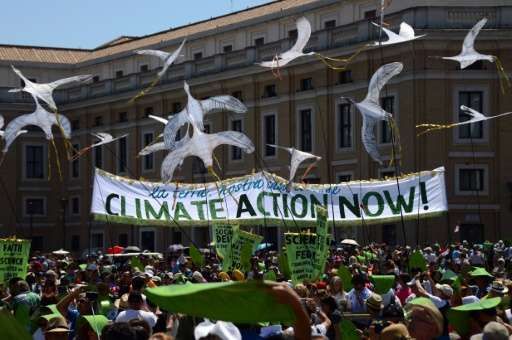An historic global climate accord calls for global warming to be stopped in its tracks at "well under two degrees Celsius" (3.6 degrees Fahrenheit) above the pre-industrial benchmark
Five months after 195 nations sealed the world's first global climate deal, diplomats gather again in the French capital Friday to start translating good intentions into reality.
The informal two-day meeting of negotiators from about 50 countries will kick off a flurry of diplomatic activity, including a formal signing of the Paris Agreement at the UN headquarters in New York next week.
"April 22 is a key moment in terms of continuing what we saw in Paris," said David Waskow, a senior climate expert at the World Resources Institute, a Washington think tank.
The historic accord calls for global warming to be stopped in its tracks at "well under two degrees Celsius" (3.6 degrees Fahrenheit) above the pre-industrial benchmark.
But national commitments to slash greenhouse gases far fall short of that hugely ambitious goal, and how to close the remaining emissions gap has yet to be worked out.
Pledges to funnel hundreds of billions of dollars, euros and yen to poor countries greening their economies and bracing for climate impacts are likewise short on specifics.
"Paris created momentum to start to grapple with some of these issues, but it doesn't mean that they are solved yet," said Alden Meyer, a veteran climate analyst at the Union of Concerned Scientists in Washington DC.
Fears that efforts would flag after the champagne was drained in December have proven unfounded, said French Environment Minister Segolene Royal, the current president of the UN climate forum.
"One could have anticipated a slowdown in the pace, but in fact we've seen an intensification of commitments," she told AFP.
There are, indeed, encouraging signs.
The United States and China—which together account for nearly 40 percent of global carbon pollution—continued their "G2" climate leadership by promising to ratify the accord quickly after the signing ceremony.
The Paris Agreement will only enter into force thirty days after 55 countries, representing at least 55 percent of global emissions, take this step.
US election wild card
Previous efforts have stumbled along this path.
The Kyoto Protocol took seven years to ratify, and even then was crippled by the refusal of the United States to do so.
This time small island states threatened by rising seas, the bloc of Least Developed Nations, and major emerging economies gathered under the BASIC umbrella have all indicated that they, too, will not drag their feet.
One major wildcard looking ahead is the US election in November.
Both leading candidates from the Republican Party have vowed to row back on President Barack Obama's climate initiatives, and could pull out of the Paris accord with the stroke of a pen.
If that happened, "would other countries continue to honour the commitments they made in Paris? That's the real question," said Meyer.
The UN's climate science panel, meanwhile, announced Thursday that its next major, three-volume report—the sixth since 1990—will be published in 2020 and 2021.
And in 2018, it will produce a much anticipated "special report" on the implications of trying to cap the rise in global temperatures at 1.5C (2.7F), a soft target that more than 100 climate-vulnerable nations fought hard to include in the Paris deal.
The raison d'etre of the Intergovernmental Panel on Climate Change is to provide governments with the data needed to make informed decisions.
UN Secretary General Ban Ki-moon is also poised to select a successor to current UN climate chief Christiana Figueres, who will step down this summer.
Picking the right person for this recently upgraded position is critical, said Meyer.
"It is a different role now that you have the framework in place," said Meyer. "There's a lot more nitty-gritty implementation to be done."
© 2016 AFP
























